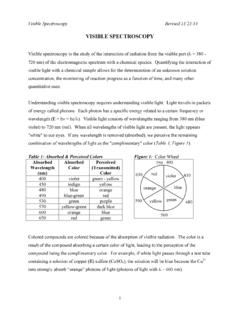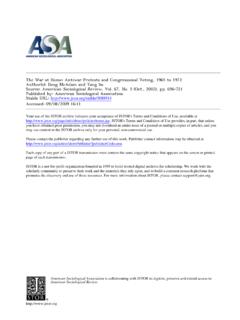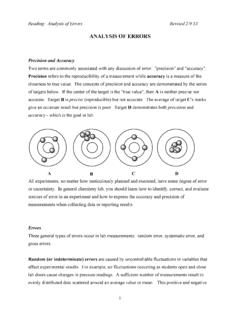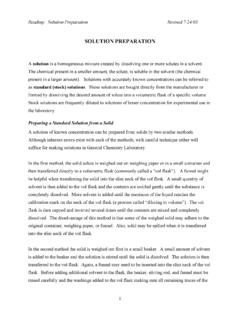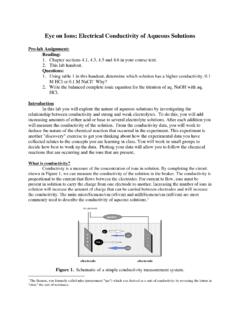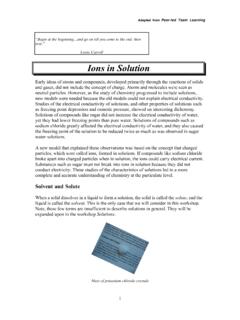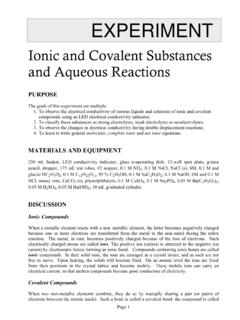Transcription of ELECTRICAL CONDUCTION IN SOLUTIONS - faculty.sites.uci.edu
1 conductivity in SOLUTIONS Revised 4/28/15 1 ELECTRICAL CONDUCTION IN SOLUTIONS Partially adapted from "Chemistry with Computers" Vernier Software, Portland OR, 1997 INTRODUCTION conductivity Electricity is typically thought of as the CONDUCTION or movement of electrons through a metallic solid (such as a copper wire) in response to the application of an electric field. However, electricity is the motion of any charged particle. In fact, electricity is observed when an electric field is applied to a liquid solution containing electrolytes (charged chemical species). Compounds that dissolve in water and form a large number of ions are known as strong electrolytes. Compounds producing a few ions are called weak electrolytes. Compounds that do not form any ions are called non-electrolytes. A compound s electrolytic strength is directly related to the amount of current that can be propagated through solution.
2 This current can be measured with a conductivity probe. An electric field is created between two oppositely charged metal plates (electrodes) located on each side of the hole near the bottom of the probe body (Figure 1). Cations move toward the negative plate and anions move toward the positive plate. Like a copper wire in a circuit, a solution containing ions completes the ELECTRICAL circuit between the electrodes (Figure 2). Eventually, all the ions would reach the oppositely charged plate, so the polarity of the plates must reverse (the negative plate becomes the positive plate and vice versa) at regular intervals to start the movement of the electrolytes all over again. Figure 1. Figure 2. conductivity in SOLUTIONS Revised 4/28/15 2 The solution conductance has the units of inverse ohms ( -1) which are formally defined as microsiemens ( S).
3 The magnitude of the conductivity value is directly related to electrolytic strength and concentration. A stronger electrolyte has more ions in solution, and, therefore, a higher conductance value. Likewise, a more concentrated solution of electrolyte has more ions in solution, and, therefore, a higher conductivity value. Furthermore, the magnitude of the conductivity value is usually directly related the mass of the electrolyte. The conductivity of a solution is typically becomes greater for electrolytes going down a group on the periodic table. A notable exception to this trend is H+, the lightest of all ions, has the highest conductivity . The reason for this is that H+ tunnels through aqueous solution by chemical reaction with H2O: H+ reacts with H2O forming hydronium ions, H3O+, which then go on to react with another H2O molecule forming a new H3O+ and regenerating the original H2O molecule.
4 This reaction sequence repeats itself over and over until H+ (probably not the original H+) reaches the negative electrode. (Hydroxide ions, OH, also have a similar interaction with H2O resulting in the second highest conductivity of all ions.) All other electrolytes have to physically push through the H2O molecules (without chemical reaction) as they move toward the oppositely charged electrode, resulting in significantly lower conductivity values. Using conductivity to Find an Equivalence Point The equation for the reaction in this experiment is: Ba2+(aq) + 2 OH (aq) + 2 H+(aq) + SO42 (aq) ! BaSO4(s) + 2 H2O(l) Before reacting, Ba(OH)2 and H2SO4 are almost completely dissociated into their respective ions. Neither of the reaction products, however, is significantly dissociated. Barium sulfate is a precipitate and water is predominantly molecular.
5 As M H2SO4 is slowly added to Ba(OH)2 of unknown concentration, changes in the conductivity of the solution will be monitored using a conductivity probe. When the probe is placed in a solution that contains ions, and thus has the ability to conduct electricity, an ELECTRICAL circuit is completed across the electrodes that are located on either side of the hole near the bottom of the probe body (Figure 3). This results in a conductivity value that can be read by the interface. The unit of Figure 3 conductivity in SOLUTIONS Revised 4/28/15 3 conductivity used in this experiment is also microsiemens per centimeter, or S/cm. SAFETY Wear safety goggles and lab aprons at all times in the lab. Some acids are very corrosive and can cause burns; wash any affected areas thoroughly with cold water. Some compounds (AlCl3, ethylene glycol, Ba(OH)2) are toxic when ingested; wash hands thoroughly before leaving lab.
6 Ethanol is flammable; extinguish any open flames or spark sources. Before starting the experiment, the TA will asks you to do a quick demonstration or talk-through one of the following: 1) The set up in part A of the experiment (what to clamp, where the buret, stir plate, beaker, and conductivity probe go) ! two student demo 2) How to use a B chner funnel (how do you disconnect the hose, what do you need to do with the filter paper first, what the B chner funnel looks like) ! two student demo 3) How to use a digital scale to correctly get the mass of BaSO4 (how do you tare the watch glass, what happens if you weigh a hot object, how many digits do you record from the scale) PROCEDURE Note: During all parts of this experiment the conductivity probe should be rinsed and placed in the beaker of water when not in use. All data files should be attached to your ELN.
7 Part A. Finding an Equivalence Point. Work in groups of three. Two people begin Part A. The third person starts making the SOLUTIONS in Part B Step #3. Make sure your TA has turned on the oven at the beginning of lab to ~110 oC. Ba(OH)2 reacts quickly with dissolved CO2 to form unwanted BaCO3(aq). Once your TA has opened the sealed, degassed Ba(OH)2 solution, you must perform the procedures in Part A relatively quickly. 1. Using a graduated cylinder, measure out approximately 50-55 mL of M H2SO4 solution into a 250 mL beaker. Record the exact H2SO4 concentration in your data table. CAUTION: conductivity in SOLUTIONS Revised 4/28/15 4 H2SO4 is a strong acid, and should be handled with care. Obtain a 50 mL buret and prerinse the buret with a few mL of the H2SO4 solution. Use a utility clamp to attach the buret to the ring stand. Fill the buret a little above the mL level of the buret.
8 Drain a small amount of H2SO4 solution so it fills the buret tip (no bubbles) and leaves the H2SO4 at or just below the mL level of the buret. Dispose of the waste solution into a 1000 mL beaker to be neutralized later. 2. Arrange the buret, conductivity probe, and stir plate as shown in Fig. 3. Set the selection switch on the amplifier box of the probe to 0-20,000 S/cm range. Connect the conductivity probe to Ch1 of the LabQuest2. If there are issues with LabQuest2 picking up the conductivity probe, select the sensors menu, click sensor setup, & pick conductivity 20000 MICS 3. Using a squeeze bottle, rinse the probe with deionized water and then blot dry with a KimWipe. Prepare the LabQuest2 for data collection by clicking on mode , and changing the mode to events with entry, name: volume, units: mL. To check that LabQuest2 is registering the correct conductivity range, submerge the probe into a small beaker of tap water (not DI water).
9 The range should be between 20-1000 S. Clean the probe again using a squeeze bottle to rinse with deionized water and then blot dry with a KimWipe. 4. This step can only be accomplished once all students in the lab are ready as stated above, Ba(OH)2 SOLUTIONS react with CO2 to form the insoluble BaCO3. Carbon dioxide dissolves in the solution quickly from room air. Avoid exhaling near the solution. CAUTION: Ba(OH)2 is toxic. Handle it with care and wear gloves! Your TA will dispense mL of Ba(OH)2 solution of unknown concentration into your 100 mL graduated cylinder. Perform the next few steps quickly to avoid BaCO3 formation. Transfer the solution to a clean, dry 400 or 500 mL beaker. Then add 120 mL of DI water to the beaker. 5. Place the beaker beneath the buret on the stir plate and clamp the conductivity probe in place as shown in Figure 3.
10 The conductivity probe a should extend down into the Ba(OH)2 solution to just above the stirring bar and should be clamped to the side of the beaker. (If the H2SO4 drips directly on the probe, false readings will occur.) conductivity in SOLUTIONS Revised 4/28/15 5 6. Before adding H2SO4 titrant, click and monitor the displayed conductivity value (in S/cm). Once the conductivity has stabilized, click . In the edit box, type 0, the current buret reading in mL. Press ENTER to store the first data pair for this experiment. 7. You are now ready to begin the titration. This process goes faster if one person manipulates and reads the buret while another person operates the computer and enters volumes. a. Add mL of M H2SO4 to the beaker. When the conductivity stabilizes, again click . In the edit box, type the current buret reading. Press ENTER.
